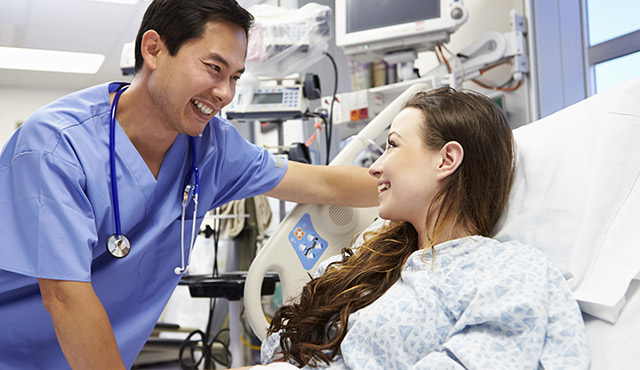They call it the “Golden Hour.”
Trauma medicine professionals know that your chances of surviving a traumatic accident are best if you get treatment in the first 60 minutes, according to Dr. Almaas Shaikh, a trauma and critical care surgeon at the Mission Hospital Trauma Center in Mission Viejo.
Outside of that window? “Your chances of surviving start to dwindle,” she says. “And the clock starts ticking as soon as the incident occurs.”
The go-to location for trauma injuries in the southern areas of Orange County is Mission Hospital’s Trauma Center.
How a trauma center works
Although the trauma center designation (conferred by the American College of Surgeons) means that it is equipped to handle any trauma, Mission Hospital treats a lot of cases that are related to the freeways and the beach.
“The most common injuries seen at Mission Trauma are motorcycle and motor vehicle collisions, falls affecting the elderly, and sports-related injuries associated with water-based recreational activities like surfing,” says Dr. Shaikh, adding that her team treats eight to 10 traumatic injuries every day.
Trauma and critical care surgeons, ER physicians, nurses, and the entire team at Mission Hospital Trauma Center are trained for this work.
Though every injury is different, the sequence of care generally goes like this: Paramedics in the field assess the injuries, then call in to a Mission Hospital nurse to report vital signs and other relevant information. That nurse uses an internal triage system to determine what level of trauma care will be activated for the patient. Depending on the level of activation, team members – from the trauma surgeon, the trauma nurse, the ER physician, and a gamut of support personnel – will respond.
“In the trauma bay they will prioritize, triage and immediately take care of anything life-threatening – breathing that has ceased, a heart that has stopped beating, a liver that is bleeding, or a collapsed lung,” says Dr. Shaikh, who graduated from the Keck School of Medicine at USC Medical School and was trained in surgical critical care at the University of Maryland.
The care doesn’t stop there. One unique feature of Mission Hospital’s Trauma Center is that a trauma nurse monitors each patient, from the moment of arrival through all critical phases of care to discharge.
Care for the caretakers
In those first critical moments of a patient’s arrival, Dr. Shaikh is the leader of the trauma team. She acknowledges that she is good at organizing chaos; still, her role is highly demanding: “The trauma surgeon’s job is to figure out what is wrong and make split-second, life-saving decisions,” she says, “all the while understanding that the outcome still may not be good, no matter that you’re doing the best you could do.”
It’s not easy. And although Dr. Shaikh and her team of professionals know to leave emotions out of the emergency room, they are affected by what they see. For this reason, Mission Hospital has in place a critical stress incident team that works with its trauma caretakers.
“They’ll talk to the trauma care team after a major critical event,” says Dr. Shaikh. “For instance after a recent house fire, they just let people talk, and express their thoughts, sadness, tears, joy or anger – allowing the healing process to begin.”
Dr. Shaikh highly values this aspect of Mission Hospital. “We are really blessed and lucky that we’re able to call on that team after a bad trauma incident. I think it is vital that we take care of the caretakers.”

